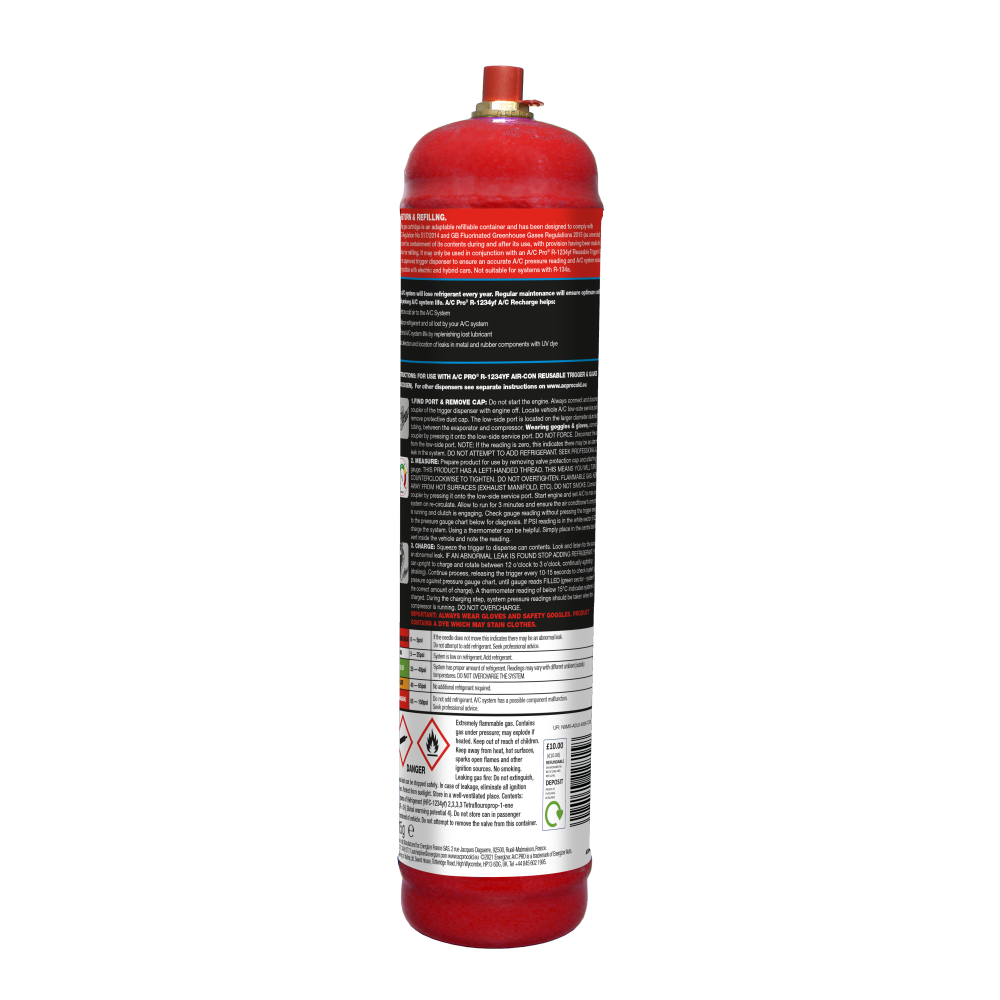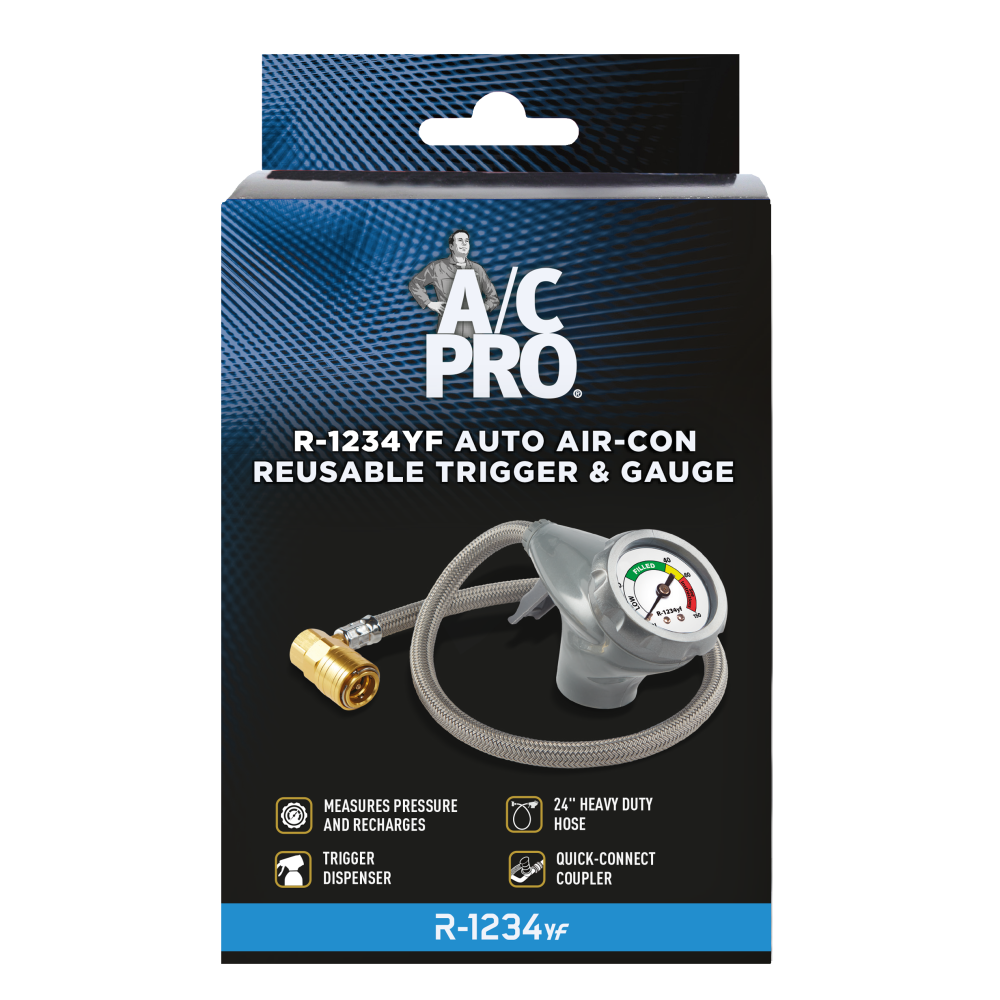AC02001EN Auto Air-Con Recharge, 510g

Product features
- Lubricates your system
- Makes air-con recharge simple
- Quick and easy
- Targets leaks
Product Description
Top up lost refrigerant and restore cold air to your car’s A/C system using our unique air-con recharge. The R-134A Auto Air-Con Recharge from A/C Pro is formulated with an advanced, patented additives package that helps lubricate your system and seal common leaks. Taking just 10 minutes, it makes your air-con recharge job as simple as the rest of your car maintenance. Just be aware it’s only designed for R-134A systems.
- Regulates refrigerant gas in R-134A systems
- Completes the job in 10 minutes
- Helps your A/C system last longer
- Seals leaks that disrupt your A/C
- Compatible with electric and hybrid cars
Usage Directions
Our R-134A Auto Air-Con Recharge works with the A/C Pro Reusable Trigger and Gauge (AC00089EN) and A/C Pro Advanced Digital Trigger and Gauge (AC00094EN).
It’s compatible with the STP Reusable Trigger and Gauge (ST00089EN) and QC-2HD R-134A Professional Measure.
- Find the port and remove cap
Do not start the engine. Always connect and disconnect with the engine off. Locate the vehicle A/C low-side service port and remove the protective dust cap. The low-side port is located on the larger diameter aluminium tubing, between the evaporator and compressor. Use the port locator on this website for help finding the low-side port.
Wearing goggles and gloves, pull back the sleeve on the quick-coupler and attach by pressing on to the low-side port. The coupler will only fit the low-side port – do not force.
Check the gauge reading and refer to the pressure gauge chart. If the reading is zero, this indicates there may be an abnormal leak in the system. DO NOT ATTEMPT TO ADD REFRIGERANT. SEEK PROFESSIONAL ADVICE.
- Measure the PSI
Prepare the air-con recharge for use by removing the valve protection cap and attaching the trigger dispenser. DO NOT OVER-TIGHTEN. Connect to the low-side port.
Start the engine and set the A/C to MAX COOL, with the system on re-circulate. Allow it to run for three minutes and ensure the air-conditioner’s compressor is running and the clutch is engaging.
Check the gauge reading and refer to the pressure gauge chart below for diagnosis. If the low-side gauge PSI reading is in the white sector (below 25psi), charge the system. Using a thermometer can be helpful here. Simply place the thermometer in the central dashboard vent inside the vehicle and note the reading.

- Charge your A/C system
Squeeze the trigger to dispense the air-con recharge can’s contents. Look and listen for the sound of an abnormal leak. IF AN ABNORMAL LEAK IS DETECTED, STOP ADDING REFRIGERANT.
Hold the can upright to charge and rotate between 12 o’clock and 3 o’clock, continually agitating (shaking).
Continue this process, releasing the trigger every 10-15 seconds to check the system pressure against the pressure gauge chart, until the gauge reads FILLED (green sector means the system has the correct amount of charge).
A thermometer reading of below 15°C indicates the system is charged. DO NOT OVERCHARGE. Do not let the needle past the green zone. IMPORTANT: ALWAYS WEAR GLOVES AND SAFETY GOGGLES.
FAQs
-
The answer here is two fold. It is possible that the system has a small leak, and now is low on refrigerant. This will allow the system to blow cold, but just not as cold as it used to. In this case check the low-side pressure and verify if the system is low on refrigerant. If it is low on refrigerant add refrigerant or a refrigerant with a stop leak to the correct pressure. If your pressure is correct adding extra refrigerant will not make the system blow out colder air, but will in fact cause the system to become overcharged. This causes the system to work less efficiently and will result in warmer air blowing from the vents.
-
We recommend using a pressure gauge to determine an accurate fill. A/C Pro’s colour-coded gauges indicate whether you should continue filling (charging) or not.
-
No. Your car’s A/C refrigerant never goes bad. Nor do you “use up” the refrigerant that is in your system. If your vehicle’s A/C system pressure is low, your vehicle has a refrigerant leak and that leak will need to be repaired in order for your system to hold refrigerant. If your vehicle is able to maintain a charge for a period of two weeks or longer, then it is possible to seal the leak with sealant such as Super Seal. If your system will not hold a charge for at least a two week period then it is advisable to seek professional assistance to find and repair the leak.



